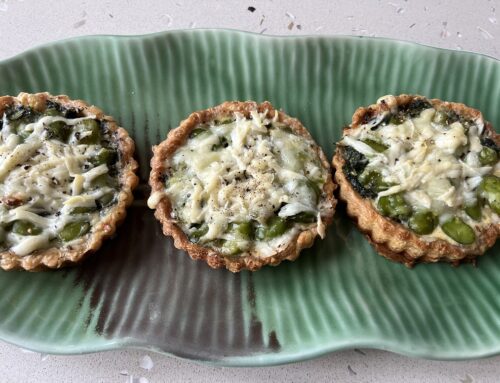
My mother was very successful making pavlovas…usually with bananas on top of the meringue,
under the cream and with a fresh passionfruit drizzled on top. Everyone loved them – they were perfect. Now, they are back in the food magazines again! so i will occasionally cook them in class. traditionally we separate the egg whites, whisk until stiff peaks form, slowly add the castor sugar, until thick and glossy and the sugar dissolved. then add the cornflour, vinegar and I always add vanilla extract. Finally, shape the mixture into a round or smaller rounds for individual pavlovas on a baking paper lined tray and cook.
 Now my dear friend Annie, who was my kitchen steward at On the Ridge , also makes an excellent pavlova,with a very old recipe from her mother! So over summer at Kureeelpa, we made her pavlova together. It is so easy, you place all these ingredients – egg whites, castor sugar, cornflour, white vinegar and 4 tablespoons of boiling water – in the mix master bowl and beat until stiff peaks form.
Now my dear friend Annie, who was my kitchen steward at On the Ridge , also makes an excellent pavlova,with a very old recipe from her mother! So over summer at Kureeelpa, we made her pavlova together. It is so easy, you place all these ingredients – egg whites, castor sugar, cornflour, white vinegar and 4 tablespoons of boiling water – in the mix master bowl and beat until stiff peaks form.
At the beginning, it is just a gooey mess, as in the photo above right, until finally it comes together into a thick and glossy pavlova mixture…quite remarkable.
However, I do still make my pavlovas using the traditional method and in my mother’s fashion!
Tell me which way you prefer!
Some golden rules in pavlova making:
- Make sure your bowl and whisk are clean – wipe with white vinegar to ensure all traces of oils are removed.
- Eggs are best when not very fresh – so about 7 days old is good.
- Add a teaspoon of cream of tartar to aid the whipping and reduce the risk of over-beating.
- Add the sugar slowly to allow it to dissolve as it is added.
- Using a fan-forced oven creates a nice crunchy crust for the pavlova






